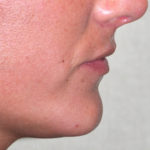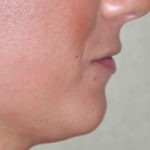Chin augmentation is a ‘simple’ and successful plastic surgery procedure for bringing the lower face into better balance with the neck and upper face. How far to bring the chin forward and how to determine that prior to surgery are important questions. But an equally important question is the difference between men and women and the chin augmentation goals between the two. While no exact statistics are known, it is fair to say that at least one-half of chin augmentation patients are female.
The traditional approach (male) to chin augmentation is to bring the most anterior chin point to a vertical line dropped down from the Frankfort horizontal line. This essentially is like dropping down a line from one’s brow prominence. While this may look quite pleasing in profile in men, such an anterior point is often too strong for many women. It is usually not aesthetically pleasing to masculinize a woman’s profile too much. I have found a few woman that felt such a chin position was too much and their implants had to be downsized slightly.


Dr. Barry Eppley
Indianapolis, Indiana



